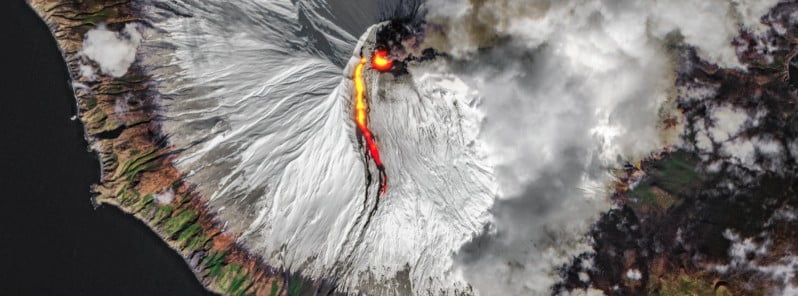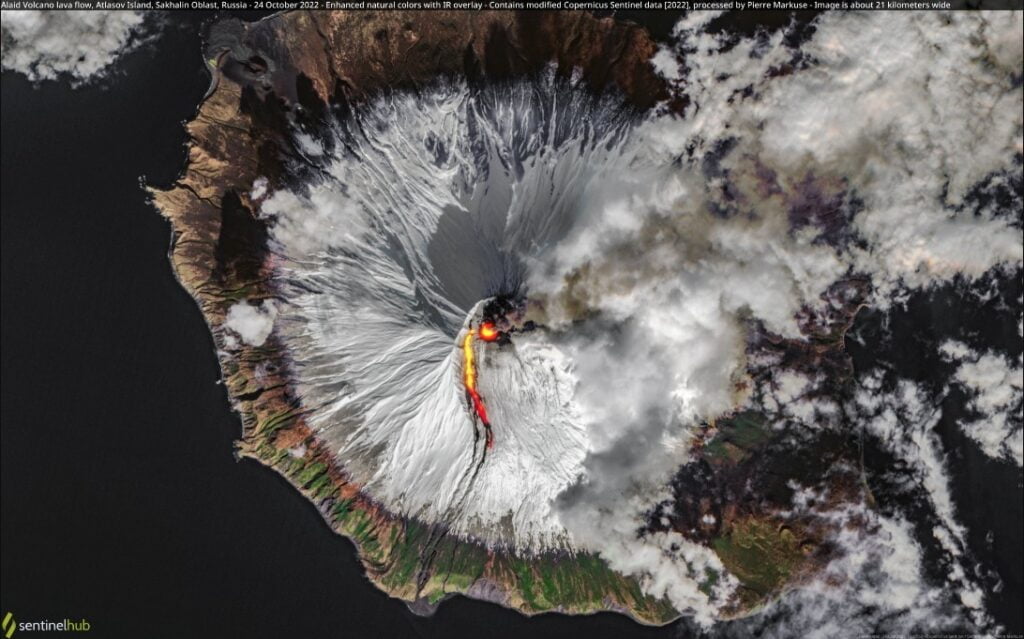Lava flow at Alaid volcano, Russia

An intense thermal anomaly was detected over Alaid volcano, Atlasov Island, Russia at 00:39 UTC on September 15, 2022, signaling the beginning of a new Strombolian explosive eruption after several years of quiescence.
- Alaid exposes high potential hazards to aircraft flying over Kamchatka and the Northern Kuriles because its eruptive clouds can rise to a height of 10 – 15 km (32 800 – 49 000 feet) above the crater and extend for hundreds of kilometers (up to 1 500 km / 930 miles)
- The duration of eruptions at Alaid can exceed several months
- Its last eruption was in 2016
As a result of the renewed activity, the Aviation Color Code was raised from Green to Yellow on September 15 and from Yellow to Orange on September 18.1
The explosive activity of the volcano increased on October 15, with ash rising up to 5.2 km (17 000 feet) above sea level and extending for 152 km (95 miles) east of the volcano.
At 23:20 UTC on October 23, ash plume was extending about 72 km (45 miles) ENE of the volcano.
Sentinel-2 satellite overflew the volcano on October 24, showing lava is again descending down its southern slope.

Alaid’s most recent eruption, which ended in January 2016, produced spectacular lava flows that flowed into the sea and enlarged the island.
Geological summary
The highest and northernmost volcano of the Kuril Islands, 2 285 m (7 496.7 feet) high Alaid is a symmetrical stratovolcano when viewed from the north, but has a 1.5 km (4 921.3 feet) wide summit crater that is breached widely to the south.
Alaid is the northernmost of a chain of volcanoes constructed west of the main Kuril archipelago and rises 3 000 m (9 842.5 feet) from the floor of the Sea of Okhotsk.
Numerous pyroclastic cones dot the lower flanks of basaltic to basaltic-andesite Alaid volcano, particularly on the NW and SE sides, including an offshore cone formed during the 1933-34 eruption.
Strong explosive eruptions have occurred from the summit crater beginning in the 18th century.
Reports of eruptions in 1770, 1789, 1821, 1829, 1843, 1848, and 1858 were considered incorrect by Gorshkov (1970).
Explosive eruptions in 1790 and 1981 were among the largest in the Kuril Islands during historical times.2
References:
1 VONA/KVERT Information Release – September/October 2022
2 Alaid – Geological summary – GVP
Featured image credit: Copernicus EU/Sentinel-2, Pierre Markuse

Commenting rules and guidelines
We value the thoughts and opinions of our readers and welcome healthy discussions on our website. In order to maintain a respectful and positive community, we ask that all commenters follow these rules.